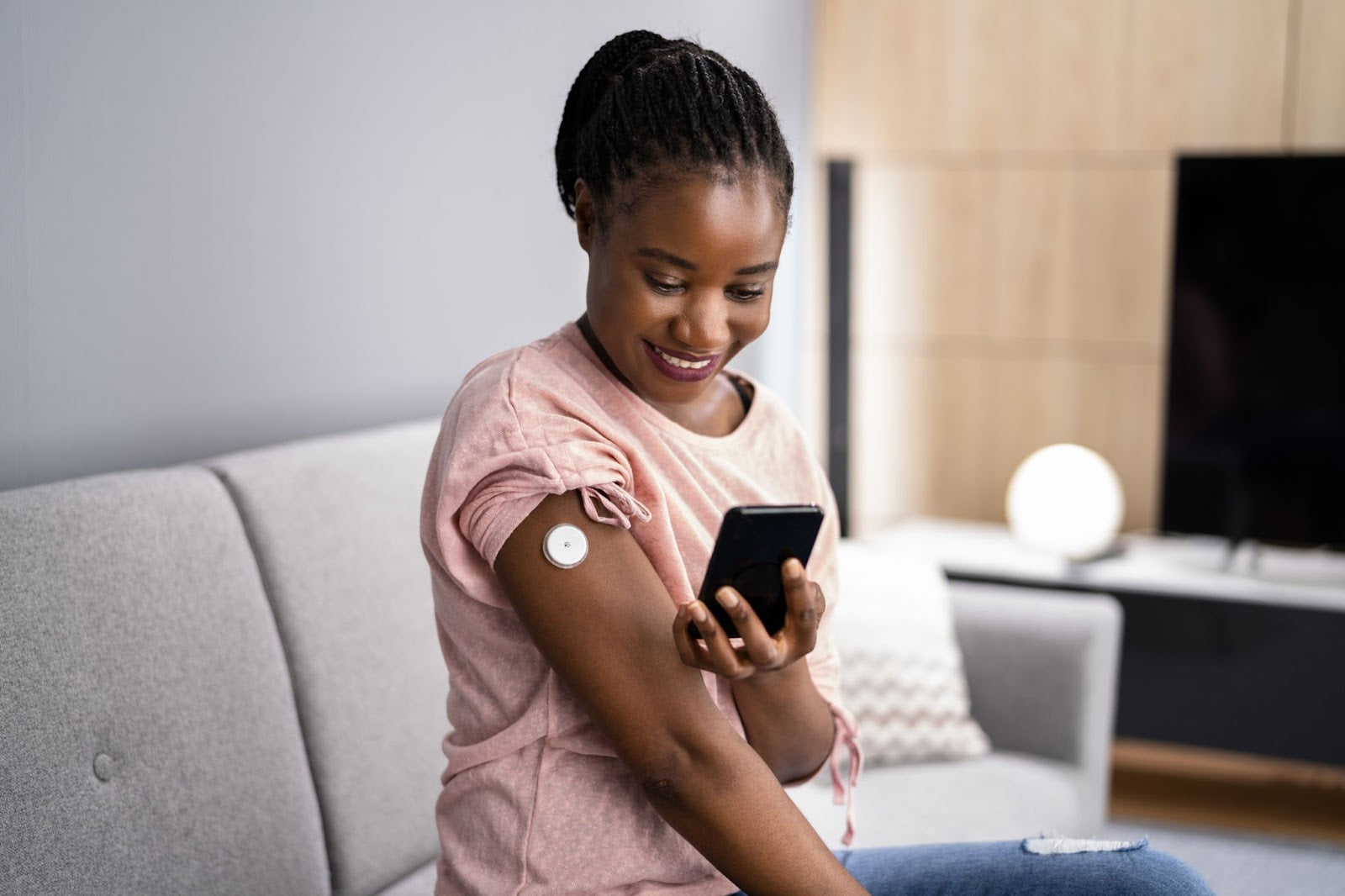Fingerstick and flash blood glucose monitoring are both effective methods of monitoring glucose patterns for diabetics.
On a broader scale, an estimated 422 million people live with diabetes around the world, and one in three Canadians lives with diabetes and prediabetes.
Those living with diabetes struggle to produce or respond to the hormone insulin. As a result, the body experiences an abnormal metabolism of carbohydrates and elevated blood glucose levels.
Whether you live with type 1 diabetes where the body is unable to produce insulin, or type 2 diabetes where the body doesn’t respond to insulin, it’s important to regularly take regular glucose readings.
What Is the Fingerstick Test?
A fingerstick test is able to measure glucose, haemoglobin A1C, ketone, lactate levels and more, ensuring that your blood has all of the essential nutrients for optimal functioning.
The fingerstick test offers an easy way to measure these nutrients by making a finger prick and drawing a small amount of blood. The blood sample is collected on a test strip without stress or pain. Once the blood sample has been collected, it is sent to the laboratory for testing.
What Is the Flash Glucose Monitoring (FGM) Test?
Flash glucose monitoring is a modern method of glucose testing that uses sensor reading technology to help measure glucose levels without pricking your finger. FGM devices are small, wearable sensors that can be worn 24 hours a day.
These devices are used in conjunction with a mobile application (FreeStyle LibreLink) on a reader or smart device. By scanning the sensor, you’re able to read the current glucose level and determine whether they are rising, falling or remaining steady.
Another useful part of the FGM test is the ability to show glucose readings for the previous eight hours which is useful for reviewing glucose trends.
Difference Between the Fingerstick Test and Flash Blood Glucose Monitoring?
Both the fingerstick test and FGM is useful for staying on top of your glucose levels, yet there are specific differences that make each test more appropriate in certain circumstances.
Method of Measuring Blood Glucose Levels
Fingerstick tests is a method of capillary blood glucose (CG) testing while FGM is a test of interstitial fluid (ISF), the fluid surrounding the cells that leak out of blood capillaries. The readings from both tests may differ as the information is sourced from slightly different areas of the body, but both are trusted to give accurate information.
On one hand, CG testing provides an instant reading on the current glucose levels. In contrast, the FreeStyle Libre FGM has a five to 10-minute delay but provides an overall perspective on the changes in glucose levels over a period of time.
As the ISF reading is taken from outside of the capillary, there are a few instances when the interstitial fluid may not accurately reflect blood glucose levels. For example;
- Hypoglycaemia (low blood sugar levels)
- Glucose levels that change rapidly
- Postprandially (after a meal)
- During or after being involved in sporting activities
Glycaemic Stability
The glucose readings can be similar when there are only small fluctuations between glucose levels. However, a greater difference will appear if the glucose levels are changed rapidly.
Glycaemic Variability
CG testing will reveal changes in blood glucose levels at a quicker rate than IST. This is true when glucose levels rise and fall. When these readings change rapidly, such as after eating, administering insulin and exercising, then there will be a greater difference between the two levels.
Why Do Diabetics Use Finger Stick Tests?
Diabetics use both methods of testing to measure their glucose data points. In most instances, glucose levels are self-monitored by using a blood glucose meter and test strips. A fingerstick test is a quick and cost-effective way to check these levels throughout the day.
Based on the instant results, diabetics can make the necessary adjustments to amend their blood glucose levels. In most instances, this involves taking a dose of insulin. Fingerstick tests can also be done by a healthcare professional.
When testing at home, the test is done with a finer lancet. A test in a clinical care setting may use a larger lancet which can sometimes be more painful.
Why Use Flash Blood Glucose Monitoring?
As technology has evolved, more convenient and efficient methods of testing have emerged. FGM testing is a modern method of testing that offers many different benefits by using a diabetes sensor. Some of these benefits include the following.
- Consistent readings rather than a single data point, with the ability to review graphs and determine patterns
- Access to trend arrows which allows you to respond to fluctuating glucose levels before they are out of range
- Monitoring of glucose levels overnight which eliminates the need to wake up and do a finger prick test
- Reduced need for finger prick checks which will only be needed with rapidly changing glucose levels, to confirm impending hypoglycaemia, to assess mismatched symptoms and correct insulin doses
- Easy to monitor, especially for very young or elderly diabetics
- Ability to share data through the application
- Reduced alarm fatigue as there are no automated alarms, only optional alarms for very high or low glucose levels, and signal loss
- Compatibility with smartphones to review results on the move
- No medication interference as the accuracy of the result isn’t impacted by the timing of certain medications
How Does the Fingerstick Test Work?
Diabetes fingerstick tests are one of the most common methods to check blood sugar levels. Those that self-monitor can do a fingerstick test at home. All that they need is a battery-powered blood glucose meter, a lancing device, and a test strip. When administered correctly, the test should reveal glucose levels as well as haemoglobin A1C, ketone, lactate levels.
The steps for home tests are fairly straightforward and include the following.
- Prepare the Lancing Device and Meter
A drop of blood is needed to test for sugar levels. Designed for single use, the lancing device should come with instructions on safe use. It’s recommended to use a new lancet with each prick to avoid dulling the point and reduce the risk of infection.
Before you prick your finger, you’ll need to have a new test strip inserted into the meter.
- Select a Spot to Test on the Finger
The Food and Drug Administration (FDA) recommends pricking the finger to get an accurate reading. When choosing the spot to test, make sure that you avoid your nail and any areas that have been scarred. It’s also a good idea to alternate sides of the finger with each prick to reduce the chance of scarring.
- Clean the Test Site
Once you’ve selected the test site, you need to make sure that it is properly cleaned. Wash your hands with soap and warm water, and make sure that your finger is properly dried or it may interfere with the glucose reading. While alcohol wipes are often used for sanitising purposes, they tend to dry the skin out which can make it difficult to draw a blood sample.
- Apply the Blood Sample to the Test Strip
Make sure that the meter is switched on and displays the testing screen. When ready, you can apply the blood from your fingertip by holding the lancing device against the test site. Apply gentle pressure and press the button to prick the finger, allowing the test strip to catch the blood drop.
- Dispose of the Testing Supplies Appropriately
When using a single-use testing kit, it’s important to dispose of the testing supplies in a safe and appropriate way. In particular, the lancet, test strip and needles for administering insulin should be disposed of in an FDA-cleared sharps disposal container. The FDA provides detailed guidelines on the safe disposal of used needles and sharp medical supplies.
How Does Flash GM Work?
Flash GM devices include a sensor that is placed on the skin on the back of the upper arm. A small electrode is inserted just under the skin and measures the level of glucose in the interstitial fluid. The sensor needs to be replaced every two weeks.
The sensor works together with a reader that views your glucose data, providing a current reading as well as an eight-hour overview and trend arrow. You simply need to scan the sensor to get the glucose and ketone readings. Depending on your preference, the reader can be a handheld device or a mobile device.
Unlike continuous glucose monitoring (CGM) which measures your sugar levels continuously, FGM only reads data when you scan your sensor.
Requirements to Perform Tests
When conducting a fingerstick test, you need to make sure that the test site is cleaned properly. The hand should be warm and have proper circulation in order to get a large enough blood sample. The lancet also needs to be sharp enough to penetrate the skin as needed.
FGM doesn’t require that you prick your skin, but the sensor does need to be embedded in an appropriate place. The Freestyle Libre sensor is placed on the back of the upper arm for 14 days to measure the interstitial glucose.
What Are the Costs of a Fingerstick Blood Test and Flash Glucose Monitoring Test?
The cost for a FreeStyle Libre Pro reader is around $65 which can be used for up to 3 years or can be replaced with a patient’s compatible smartphone. Each individual sensor that lasts 14 days costs around $100.
While the cost of fingerstick blood test supplies is less, they need to be replaced with every use. The exact cost varies around the world, but a test strip costs approximately $0.7 in Canada. Other costs to consider include the lancet.
Which One Is Better?
Both the FGM and fingerstick glucose test serve a specific purpose depending on your needs. While a fingerstick test can be more painful and inconvenient, it offers instant results. As a no prick glucometer, a flash glucose monitoring test is less disruptive and offers insight into glucose trends. However, the accuracy is not as exact.
Understanding the difference between the two tests is an essential step in deciding which is best for you. A healthcare professional should be able to offer advice on how best to approach your diabetes management journey.
This article offers general information only and is not intended as medical or other professional advice. A healthcare provider should be consulted regarding your specific situation. While the information presented is believed to be factual and current, its accuracy is not guaranteed and it should not be regarded as a complete analysis of the subjects discussed. All expressions of opinion reflect the judgment of the authors as of the date of publication and are subject to change. No endorsement of any third parties or their advice, opinions, information, products or services is expressly given or implied by Mednow or its affiliates.
Get Started
